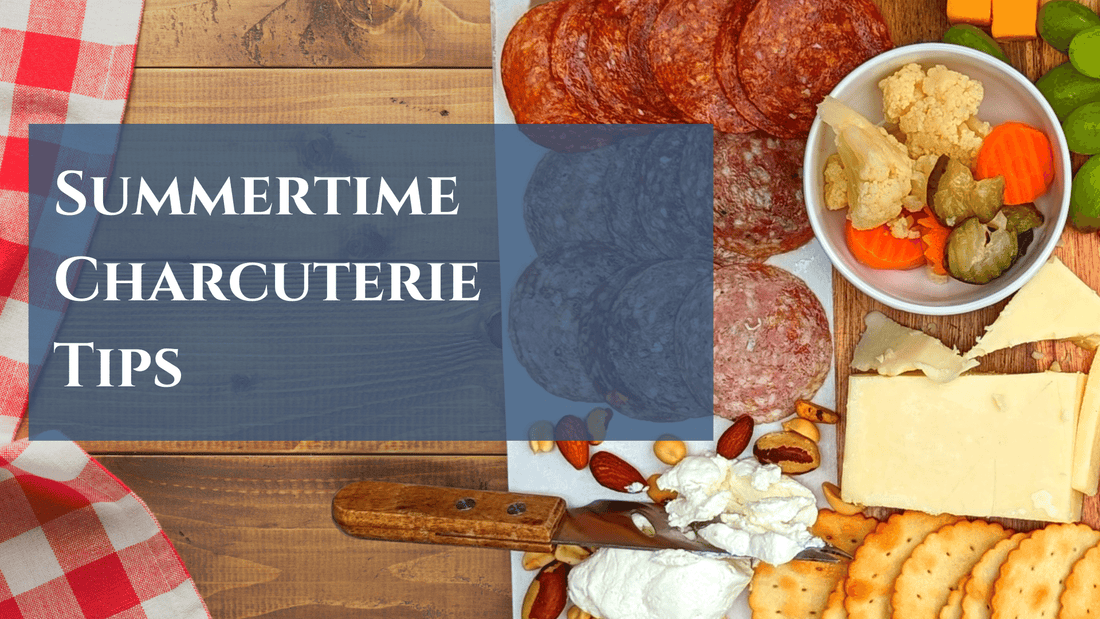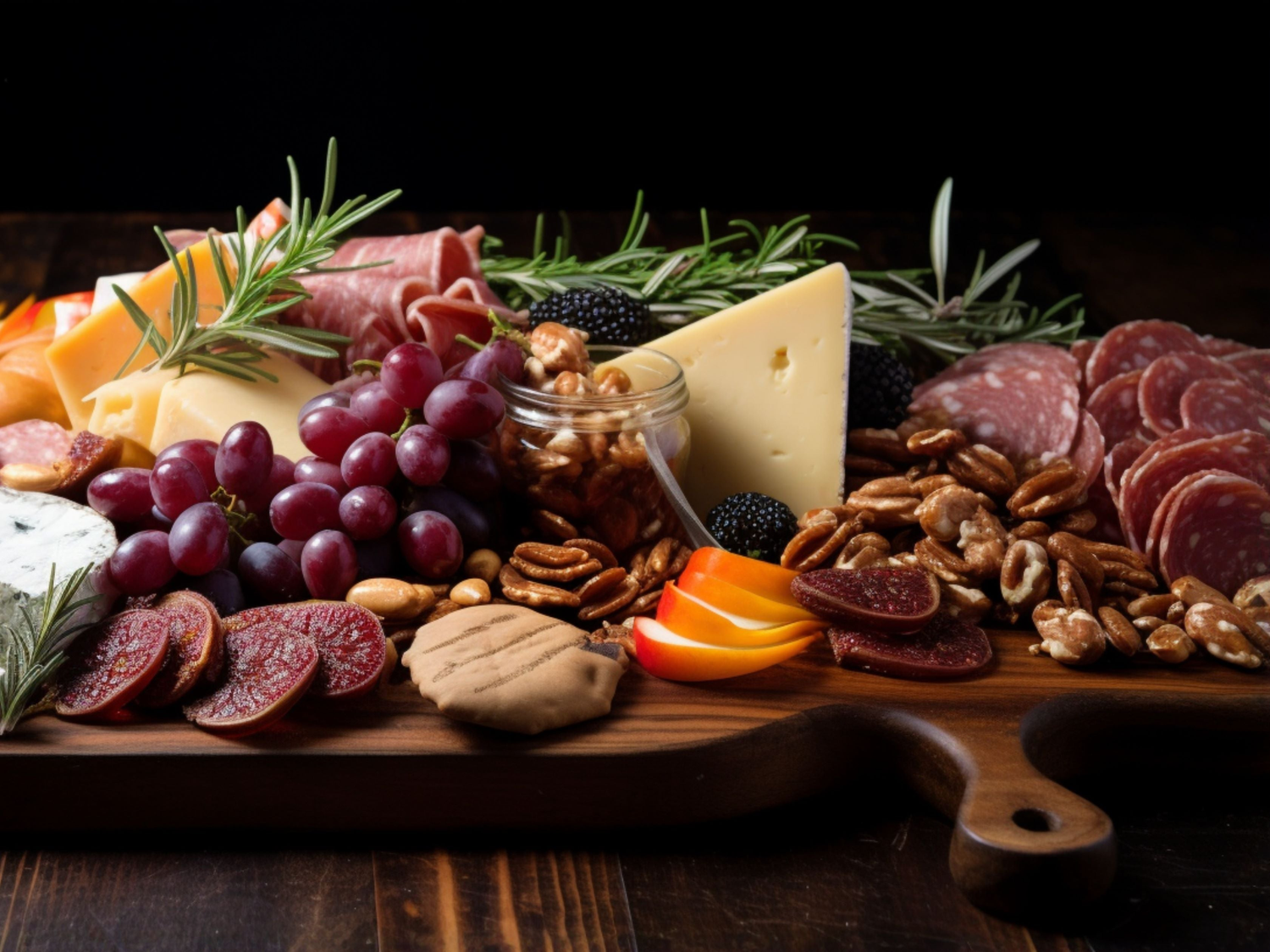
How long can a charcuterie board sit out? Summer cheese board guide
Summer’s in full swing at our home. For us, that means days are a bit less structured and we are taking advantage of the longer daylight hours we get this time of year...meaning people are in and out all afternoon into the evening.
That also means that dinner can be harder to plan. And this is when my charcuterie board really comes in handy. Instead of trying to cater to everyone’s activities, I can arrange a charcuterie board in the late afternoon and let it do its magic.
As people get hungry, they can nibble on some yummy fruit, cheese, meat, bread; refill the board as needed; and head back out to play.
Voila! Dinner is served.
But these warmer months do beg the question: How long can a charcuterie board sit out unrefrigerated before the dairy and meat turns into a summer science project? Read on for my personal tips for how to prepare charcuterie in the summer.
No time to read? Download the PDF booklet.
Do cured meats and hard cheeses need to be refrigerated?

Now this is when it gets into a bit of a gray area. If someone asked me, “Does meat and cheese always have to be refrigerated?” My short answer would be, “Yes. And no.”
In some cases, you don’t need to refrigerate any of the products. Dry whole salami and American-style country ham are well-preserved, as with most other whole or vacuum sealed dry-cured meats.
Aged hard cheeses, like parmigiano-reggiano, hard cheddar, or gouda I store on a shelf in my pantry. Therefore, they are just fine left out whether they are whole or cut. I serve a lot of aged cheddar on my summer charcuterie boards for this very reason - It's worry free.
And some foods actually lose nutrients when they’re refrigerated. When it comes to certain fruits, cold air inhibits the ripening process and breaks down antioxidants.
However, as a general rule, I do store my charcuterie and MOST cheeses in the refrigerator. Uncut young ripened cheeses will last unrefrigerated for about a week before they start to spoil. Once cut though, they need to be refrigerated. Fresh unripened cheeses and uncured meats, like cold cuts, must be refrigerated (I tend to avoid these on my board during the summer months).
Smoked, wet-cured, and pre-sliced charcuterie usually needs to be stored in the refrigerator, especially if it hasn’t been dried too. Sometimes you can buy smoked and pre-sliced meats that have been cured with salt enough to dry to a certain level and are sealed - these guys can be unrefrigerated until ready to open.
Almost all dried, salt-cured, and/or smoked meats are fine if left out for a few hours though. Two of my favorite go-to meats for charcuterie snacks are homemade smoke-dried jerky and Landjaegers. However, my general rule is once the inner (not the crust) meat is exposed to air, the clock starts ticking. Even dried meats like jerky will start to absorb moisture from the air once out of the sealed package and start their countdown too.
How do you extend the life of a charcuterie board?
When I serve up my summer charcuterie boards, I only prepare a small amount of edibles at a time. This helps limit the amount of food left exposed to air and room temperature, which for us even on a hot summer day is only about 70 degrees F (21 degrees C).
But I’ve never had a problem, at this temperature, leaving cured meats, fruits, and cheeses out for a few hours. I’d say a very conservative estimate on time out at room temperature, per USDA recommendations, is about 2 hours (I’ve left mine out closer to 4 hrs when it’s a cool day, but most people don’t have temperatures in the 60s in the summer).
Note: The warmer it is in your house, the shorter amount of time you can leave food out! When your indoor temperature starts to edge toward 90 degrees F (32 degrees C), that length of time drops to only an hour!
As far as the softer cheeses go, you do need to be a bit more concerned about spoilage.
To help with this, a couple of tricks:
1. I make sure my softer cheeses are made from pasteurized milk.
2. I only use ripened cheeses for my soft cheeses. These cheeses are the ones with a soft rind, like brie or muenster.
3. During the summer, I bring out my marble and acacia charcuterie board. The marble side keeps cheeses cooler longer.
Charcuterie board accompaniment foods that are temperature-resistant include:
-
Nuts - Almonds, cashews, and other nuts are resistant to spoilage and can help round out the stronger flavors on your board.
- Breads and crackers - If you’re worried about your bread becoming stale, keep it covered and only slice the bread as needed.
- Stone fruit - These foods require no refrigeration and add a splash of color and sweetness to your board. Peaches, plums, and cherries are included in this category.
Tip: If you’re worried about the fruit changing color once it’s cut, squeeze some lemon on it! The citric acid keeps your fruit from browning and helps bring out the natural flavors.
-
Fresh vegetables - Some vegetables do not need to be kept in a refrigerator. Cucumber, eggplant, and peppers are just a few vegetables safe for a warm-weather charcuterie board.
-
Pickled vegetables - The salt and vinegar in pickled vegetables helps keep them fresher longer. Refrigeration slows the fermentation process, but you won’t need to worry about significant fermentation during a party.
-
Butter - A little-known secret is that butter can be kept covered on the counter. The fact that it is both creamy and requires no refrigeration makes it a great candidate for your charcuterie board. Add some herbs or apples to the butter for a savory or sweet spread.
- Honey - It’s no secret that honey doesn’t require refrigeration and that it helps balance more savory foods. You may try pairing it with aged cheddar, which, as we mentioned earlier, is resilient when it comes to warm temperatures.
The foods I mentioned above are wonderful, but we also love our meats and cheeses! So to reduce the amount of precautions we have to take, we sometimes plan our board around the weather.
Another trick I’ve heard of, is keeping your charcuterie board in the refrigerator until it’s time to eat. The cold board helps keep the temperature of the foods lower for longer once taken out.

How can you tell when it’s time to discard the food?
No matter how many precautions we take - how soon we pick the vegetables, how long we refrigerate before serving - sometimes food goes bad.
Be on the lookout for the following clues:
Look at it: If it looks funky - has a strange color to it, or polka dots when it shouldn’t - then it’s probably not good to eat.
Smell it: If it smells off (and you’ll know when it is – if you’re wondering what “off” smells like, then you probably haven’t experienced “off” yet then) then don’t eat it.
When in doubt – don’t eat it.
The USDA notes that you can’t see, smell, or taste the bacteria that can cause foodborne illnesses (this is why it’s advised to discard some foods that seem perfectly fine when they’ve been out in the open too long).
That said, your charcuterie board is likely going to last longer than you think. But, it can’t hurt to take a few of the safety precautions mentioned above, particularly during the summer months. By following our tips, you can enjoy your charcuterie board to the fullest and avoid any pesky stomach pains later on.
Get Our Free Cheat Sheet for Summer Charcuterie

Our one-sheet guide to summer charcuterie includes all of the following:
- Shopping list
- Pairing ideas
- Safety tips
Fill out the form, and we'll send it to you instantly.

